|
NATIONAL PARK SERVICE
Fauna of the National Parks of the United States No. 1 A Preliminary Survey of Fauna Relations in National Parks |

|
METHODS ADAPTED TO FAUNAL INVESTIGATIONS IN NATIONAL PARKS
When the survey party went into the field in May, 1930, its members purposely had not formulated an outline of procedure in advance. Preparations were confined to assembling the necessities for living in the open under a variety of conditions and the paraphernalia for making observations and recording data. The essentials consisted of a sturdy field car, camp goods, photographic supplies, collecting kit, and a few standard reference books.
It had been previously agreed that an independent procedure, that is, one guided by no former experience or prejudice, should be developed from knowledge gained on the ground. If the findings were to have even a fair chance of being unbiased, there must be freedom from any preconceived method of survey. It was believed that this approach would favor the development of the technique best suited to the problem.
The importance of starting in this manner is best explained in the object of the survey. The only reason for attempting this practical type of investigation was to provide park administrators with data which would help them to meet a new and difficult situation. How could the animal life be conserved under natural conditions and still contribute fully to the benefit and enjoyment of the people?
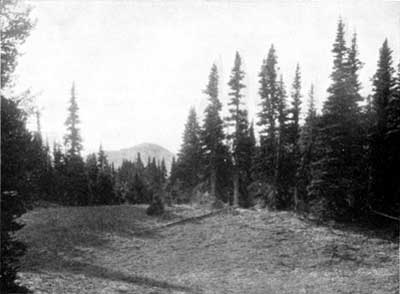 FIGURE 4. – A high mountain glade, soon to be converted into a camp ground. "How could the animal life be conserved under natural conditions and still contribute fully to the enjoyment of the people?" Photograph taken October 4, 1930, near Shadow Lake, Mount Rainier. Wild Life survey No. 1327 |
As for individual biases, there were already too many. The park superintendent stood at the crossroads between the wild life and various groups of interested persons with their conflicting biases. Among them were those of the man who judged the park in terms of fish in its streams, the hunter who wanted the maximum production of game though he could not shoot it, the scientist who would exclude people from large areas in order that their potentialities as pure cultures for zoological research might not be destroyed, the visitor who would prefer to have the animals fenced by the road side for easy inspection from his car, and the person who eschewed the intrusion of any artificiality, even a road, in the native haunts of the wild creatures. Nor can one forget such well-meant suggestions as that of the cattleman who wanted to place a herd of purebreds along the entrance road inside a park in order to add to the interest – and so it would, for him and many other stockmen.
It was believed that the type of investigation which would come nearest to satisfying the needs of the Service was one that would furnish accurate data on the status of parks' fauna, with due emphasis on the economy or human relationships of each species. For this reason, the first weeks were devoted to the study of each park visited in its entirety, trying to analyze all factors which either affected the animal life or, conversely, were themselves influenced by the animal life. The administration, the visitors, structures erected by man, and the territory outside the park were scrutinized just as much as the animal populations. The vertebrates themselves received much the larger share of attention later on, but these other factors continued to figure prominently throughout.
The plan of procedure and the methods evolved in these first weeks were practiced and further developed throughout the period. This plan is discussed here and then presented in outline form for reference in subsequent studies. Four distinct steps or divisions were recognized as necessary to the completion of a survey, though at least three of them might be undertaken simultaneously.
FOUR STEPS IN SURVEY'S PROCEDURE
The first step is to reconstruct the picture of the fauna of the area as it existed in its undisturbed environment before white men came. This logically is the first thing theist must be known, because the object of all subsequent work will be to study the changes which have occurred in the meantime and to restore or maintain, as the case may be, the faunal part of this early picture.
The second step is to study the history of the area under man's dominance. This serves to reveal the causes for the present maladjustment of many species. Roots of existing conditions are often buried deep in the past, and before they can be understood and corrected these roots must be dug out.
The third step is so obvious that it requires little comment. It involves a complete survey of the vertebrate life as it exists in the park at present, inclusive of systematics, life history, and ecology, with a complete treatment of man as one of the environmental factors.
The fourth step is to draw up an initial broad management plan that will guide wild-life administration towards the general objective, which is to approach as nearly as possible the picture set up in the first step. This plan should be elastic and must be subjected to constant revision on the basis of future studies or it will soon become obsolete.
Thus, in any park, the determination of original conditions will provider the goal of management. Study of the historical past and of present circumstances will provide the working data upon which the management plan of the future can be built.
THE PRIMITIVE WILD-LIFE PICTURE
It is true that flora and fauna and even geography itself have been in a state of flux since the continents first rose from the sea, and in this sense there is no one wild-life picture which can be called the original one. Nevertheless, practical considerations determine one point in time which satisfies wild-life-survey requirements as regards a particular area. This is the period between the arrival of the first whites and the entrenchment of civilization in that vicinity. We can know little of the other pictures that preceded this period and violent changes occurred immediately afterward. Consider this from another viewpoint. The rate of alteration in the faunal structure has been so rapid since, and relatively so slow before, the introduction of European culture that the situation which obtained on the arrival of the settlers may well be considered as representing the original or primitive condition that it is desired to maintain.
When it comes to defining the original status of each animal in a region, allowance must be made for cyclical fluctuations in animal populations. In some species the high and low ebbs in density per unit area may be extreme even under normal conditions. However this occurs more noticeably in the smaller forms with a high birth rate.
Along with learning what species comprised the fauna of the area, what the abundance of each was, and what range was occupied at each season, as much information as possible should be assembled on the vegetative cover. Where the plant life has changed as to composition and distribution, it would be fruitless to hope that the animal life could remain the same.
Obstacles to reconstructing the primitive picture are great in any instance, but they increase in places where the pioneer period dates very far back. The material evidence was largely perishable and may have been completely destroyed. Accounts that have passed from mouth to mouth are likely to be worse than useless. People who left any written record were few, and of these still fewer could be counted reliable observers.
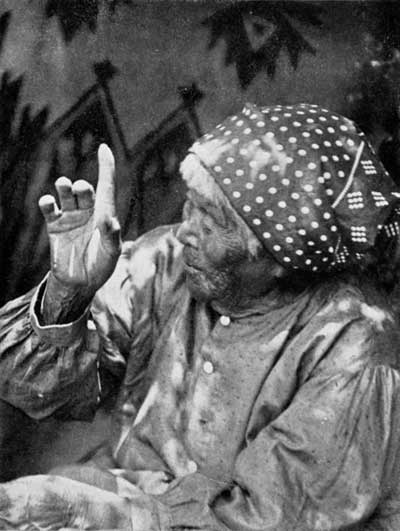 FIGURE 5. – Maria, last of the Yosemites, told the party about early wild-life conditions in the valley. The records of first-hand observations are important and should be sought before it is too late. Photograph taken July 7, 1929, Yosemite. Wild Life Survey No. 324 |
Yet every small fragment of fact that can be sifted out and added to the mosaic is of value and will become much more so all the time. Because the chance of completing these early pictures grows less each year, this part of the survey should be undertaken immediately and pushed as rapidly as possible. In the West some of the pioneers who first saw the regions that are now national parks are living, so that first-hand statements can still be secured. The record of primitive conditions should be carefully substantiated as it is drawn up. The park museums are the proper repositories for accumulated evidence.
Old game trails, salt licks, and wallows tell a story that can be recorded photographically. Shed antlers and old horns, as well as other skeletal remains, give clues to the type of habitat occupied under natural conditions and to the original range of species which may have been extirpated since or forced to change their haunts.3 Evidence of this sort should be photographed in place, and both specimens and pictures placed in the local museum.
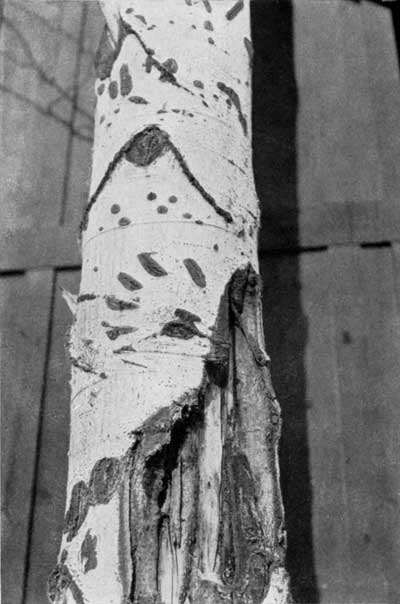 FIGURE 6. – Claw marks on trees may tell the story of bears that have since disappeared. Photograph taken at Tower Falls Ranger Station, Yellowstone, July 14, 1931. Wild Life Survey No. 1929 |
References to animal life in early writings should be treated in the same way.4 Where the original letter or document can not be secured, photostatic copies, accompanied by full data on the source, will serve very well. Pertinent material may be gleaned from newspapers, periodicals, scientific reports, travel accounts, and even from historical fiction built around frontier life. In this connection, maps, paintings and drawings by both white men and Indians should not be overlooked. Just as with the restoration of Williamsburg, the search for clues to the restoration of the early picture may lead almost anywhere, not excepting the Old World.
3 Mammal Remains from Two Prehistoric Village Sites in New Mexico and Arizona, by Lyon, Marcus Ward, Jr., Proc. U. S. Nat. Mus., vol. 31, 1907, pp. 647-649.
4 U. S. Geological Survey of Montana, Idaho, Wyoming, and Utah, 1872, by Hayden, F. V., 1873.
HISTORY OF FAUNA UNDER MAN'S INFLUENCE
This second step of a wild-life survey might be likened to making a moving picture as compared to the first step just discussed, which is more like assembling the elements of a still picture. The primitive picture melted into a rapidly changing scene when people came in numbers. The historical study will discover the new influences at work on the fauna and some of the results.
This study has two parts. Tracing the story since the date of the creation of the park is relatively much the easier part. Superintendents' reports provide a continuous record. Animals and birds of a park are under constant observation by members of the administrative staff. Scientists have used parks for research laboratories and published their findings. Such complete studies as Animal Life in the Yosemite5 and Vertebrate Natural History of the Lassen Peak Region6 are of invaluable assistance here.
The more difficult part of the historical study is to trace the factors affecting the fauna of the area backwards from the time it was made a park to the days of its discovery and exploration. Yet this is likely to be the most important period, for the influences most inimical to wild life held their greatest sway then. The history and effects of these early influences must be sought out if the present status of the vertebrates is to be really understood.
The several major occupations of man in wresting a living from the new land have each left an imprint on the fauna. Where the activity was trapping and hunting, especially market hunting, the effect was soon apparent. Other pursuits, such as cattle raising and farming, had influences which were not always so conspicuous, but the ultimate harm done may have been even greater. The impoverishment of the range by domestic stock has had an almost incalculable effect upon the native life. It was most obvious on the game, but, of course, the predators were involved in turn, and so on. As is always the case with Nature's ecologic structure, the disturbance of one species has repercussions the end of which we are as yet unable to see or predict. It would be hard to find any form of wild life that was not in some way affected by stock on the range. Agriculture caused many changes. Irrigation destroyed certain animal-plant communities, replacing them with others. Ranches preempted valley bottoms which were critical areas for the game populations of entire mountain areas in severe winters, thus threatening their complete annihilation. Cultivated crops favored the enormous increase of certain rodents over the normal numbers for wild land. Accidentally and intentionally, the farmers introduced exotics. Railroads and logging operations likewise had their share in the changes that took place. Game ranges were divided. The fire element was magnified. Forest cover was removed bodily.
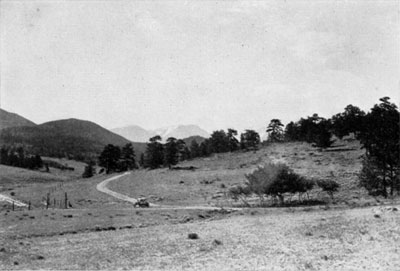 FIGURE 7. – Ranches preempted valley bottoms which were critical areas for game in winter. Photograph taken June 26, 1931, in Beaver Park, Rocky Mountain. Wild Life Survey No. 1845 |
In studying the history of the areas in relation to the effect upon wild life, it is helpful to group the influences by the different phases of human activity which caused them. In doing this, faunal fluctuations not traceable to civilization must not be overlooked.
Methods for this second step of the survey are much the same as would be invoked for the first step, and so do not need to be discussed separately here. But the difficulties are less in proportion that there is much more material to draw upon.
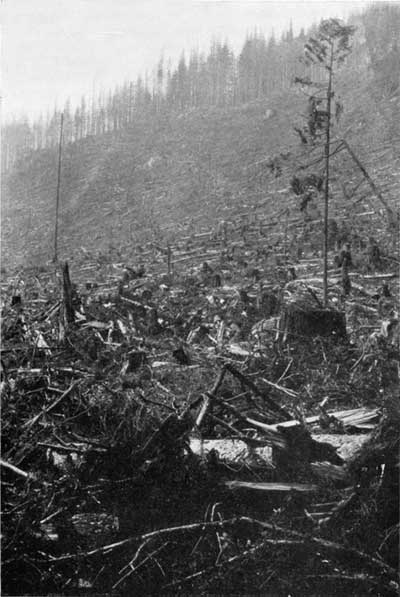 FIGURE 8. – Near many parks, forest cover is being removed bodily and the fauna must change in consequence. Photograph taken September 17, 1931, at White River entrance of Mount Rainier. Wild Life Survey No. 1847 |
5 Animal Life in the Yosemite, by Grinnell, Joseph, and Storer, Tracy I. University of California Press, Berkeley, Calif., 1924.
6 Vertebrate Natural History of a Section of Northern California Through the Lassen Peak Region, by Grinnell, Joseph, Dixon, Joseph, and Linsdale, Jean M. University of California Press, Berkeley, Calif., 1930, pp. 85-86.
SURVEY OF PRESENT STATUS OF VERTEBRATE LIFE
Though this step is a more satisfactory one to undertake than the first two in that it is clean-cut with all materials at hand, it is also the most exacting as to thoroughness of the results required.
First a complete study skin collection for the area should be made and housed in the park museum. Large series of skins are not necessary, but each species should be represented in all seasonal and developmental phases.
The life history of each species should be worked out for that area. It is not sufficient to have reference to the behavior of a closely related form or even the same form in another distant locality. Needless to say, the life-history studies would not approach completion for many years, even though systematic studies were instituted immediately.
In this basic vertebrate survey a highly important phase is the study of the park animals, in a new environment with man as a potent ecological factor. Man in the park must be considered as part of the whole that is the park. Thus, the effects of his presence on the wild life must be carefully analyzed and dealt with as continuing problems in whatever administrative plan is finally adopted.
DEVELOPMENT OF A MANAGEMENT PLAN
Not until the three foregoing steps have been substantially worked out for a given area will it be possible to set up a management plan that can be characterized by any other name than make-shift. The task may be considered burdensome, yet without a program of wild life administration based on a painstaking survey containing all these elements the wild life will deteriorate further and further.
The foregoing discussion explains the wherefore of the several steps in procedure developed in the course of the preliminary wild life survey and which were followed out as far as possible considering the broad field and the time allowed. This plan is here presented in outline form, indicating the methods for securing the data required in the first steps and suggesting how the last step, the administrative plan, can be predicated on this data.
RECAPITULATION
The foregoing discussion explains the wherefore of the several steps in procedure developed in the course of the preliminary wild life survey and which were followed out as far as possible considering the broad field and the time allowed. This plan is here presented in outline form, indicating the methods for securing the data required in the first steps and suggesting how the last step, the administrative plan, can be predicated on this data.
OUTLINE OF FAUNAL-SURVEY'S PROCEDURE
I. Determine original status of fauna in the park region.
Object –
A. To define the goal of wild-life management.
B. To establish definitely the comparative basis for analyzing subsequent faunal changes.
Method –
A. Study the evidence on the ground.
- Old game trails, salt licks, wallows, etc.
- Skeletal remains, horns, antlers, etc.
B. Interview pioneers, early residents, etc.
C. Search written records.
- Letters and diaries.
- Printed sources, inclusive of periodicals, books, scientific reports, etc.
- Paintings and drawings by Indians and white men.
II. Determine the history of the fauna of the region under white man's influence.
Object –
A. To trace causes of present conditions.
B. To learn what unfavorable influences may be averted in history yet to be made in newer projects.
Method (in general, the same methods as outlined under I, above, are applicable) –
A. Study the era prior to creation of park by the several steps of economic development in that region.
- Direct influences.
a. Trapping.
b. Hunting for sport.
c. Market hunting.- Indirect influences.
a. Grazing.
b. Agriculture.
c. Lumbering.
d. Railroad development.B. Study history of the fauna under park administration.
- Investigate history of wild-life administration.
a. Poaching and patrol.
b. Predatory-animal control.
c. Other protection and management measures.- Determine effects of development as a national park.
a. Increase of visitors.
b. Road and structures developments.
c. Developments adjacent to park boundaries.III. Intensive survey of present vertebrate life of the park.
Object – To learn as much as possible about all forms and their economy.
Method –
A. Make a complete study skin collection for the park museum.
B. Work out life histories of all species.
- Concentrate first on species facing greatest danger and carry on to eventually include all.
- Study the park animal in relation to the status of that species throughout its range.
- Study other attempts to conserve certain species for hints in park work.
C. Study the human factor as a permanent factor in the ecology of the area.
IV. Develop a management plan.
Object –
A. To maintain elements in present picture that still approximate the primitive state.
B. To devise ways of restoring species which have departed from their original status.
C. To make adjustments for species which can only be saved under semiartificial conditions.
Method – The management plan will be based on the data secured in the first three steps of the survey and will be developed as the result of experience in applying the knowledge so gained.
| <<< Previous | <<< Contents>>> | Next >>> |
fauna/1/chap2.htm
Last Updated: 01-Feb-2016